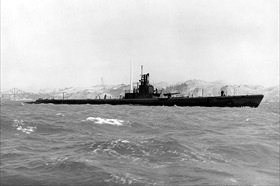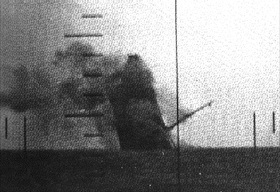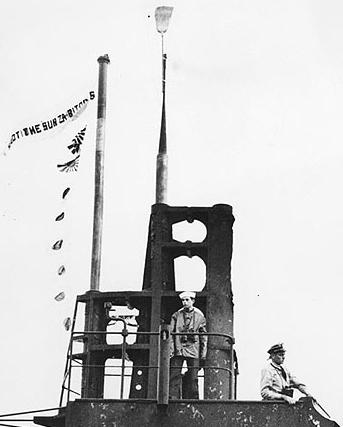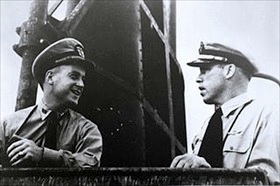NEW U.S. TORPEDO SINKS JAPANESE SHIP
Washington, D.C. · October 5, 1943
On this date in 1943 the Japanese news agency Domei acknowledged that the 8,000‑ton Konron Maru was sunk by an American submarine off the west coast of the Japanese home island of Honshū, with the loss of 544 lives. The troopship was sunk by the USS Wahoo using the new, still not perfected Mark 18 electrically propelled torpedo based on a German design, the G7e, several of which had been retrieved by the Allies after running ashore. The Wahoo, skippered by the legendary Dudley “Mush” Morton, was one of the most celebrated submarines of World War II, sinking 27 ships, totaling 119,100 tons, and damaging two more, for an additional 24,900 tons, in six patrols, more than any other submarine of the time. On this, her seventh and last patrol, the Wahoo was credited by the Japanese with sinking four more ships (this included the previously mentioned Konron Maru), for 15,144 tons using Mark 18 torpedoes before enemy antisubmarine forces sank her in the La Perouse (Soya) Strait between Russia’s Sakhalin Island and the northern Japanese island of Hokkaidō on October 11, 1943, with a loss of all hands (80 men).
The advantage of the Mark 18 was that it could be fired in shallower waters than the older steam torpedoes like the Mark 14, and it left no telltale wake of exhaust or bubbles to disclose a submarine’s location—an important virtue in daytime engagements. The Mark 18 was 20‑1/2 ft long and 21 inches in diameter. The torpedo weighed a little over 3,000 lb, had a warhead of 600 lb of Torpex (50 percent more powerful than TNT by mass) with a contact exploder, and with its 90 hp direct-current electric motor had a (relatively slow) speed of 29 kt (33 mph) and a maximum range of 4,000 yards.
The Mark 18 had one serious defect, though: it had no protection against circular runs. A circular run claimed the USS Tang for certain and possibly other U.S. submarines. (Tang’s nine survivors, including its skipper and former Wahoo executive officer Richard O’Kane, were picked up the next morning by a Japanese destroyer and interned until the end of the war.) By July 1944, an improved Mark 18 appeared. Some 30 percent of torpedoes fired by U.S. submarines in the Pacific War were Mark 18s.
![]()
USS Wahoo, 1941–1943
 |  |
Left: The USS Wahoo off Mare Island Navy Yard, California, 1943. Its skipper was Lt. Cmdr. Dudley W. “Mush” Morton (1907–1943), the first superstar of the U.S. submarine service. Recognized as a “One-Boat Wolf Pack,” the Wahoo received the coveted Presidential Unit Citation.
![]()
Right: The Japanese freighter Nittsu Maru sinks after being torpedoed by the USS Wahoo on March 21, 1943. Within six hours of the surprise Japanese attack on the U.S. Pacific Fleet anchored at Pearl Harbor, Hawaii, the U.S. Navy adopted a policy of unrestricted submarine warfare against Japan. American submarines attacked without warning warships, commercial vessels, and civilian passenger ships flying the Japanese flag. From 1943 Allied subs waged an increasingly effective campaign against ill-protected Japanese merchant shipping and the Japanese Navy. By the end of the war in August 1945, the Japanese merchant marine had less than a quarter of the tonnage it had in December 1941, when it already had a deficit of 40 percent in ship bottoms flying flags of Japan’s new enemies. A tragic consequence of this “sink ’em all” campaign is that more than 20,000 Allied POWs transported in Japanese “hell ships,” as they were known, died when the ships were attacked by Allied submarines (at least 8 different U.S. submarines) and aircraft.
 |  |
Left: Affixed to the Wahoo’s periscope is a broom (top center in photograph), which the sub proudly displayed on its return to Pearl Harbor in 1943. The broom indicated that the oceans had been “swept clean” of the enemy. The pennant flying from the snorkel reads, “Shoot the sunza bitches.”
![]()
Right: Morton (left) speaks with his executive officer, Richard O’Kane, on the bridge of the Wahoo days after torpedoing the Japanese troop transport Buyo Maru north of New Guinea on January 26, 1943, on the sub’s third patrol. O’Kane would later assume command of the USS Tang.
History Channel Presentation: Submarine Warriors Dudley “Mush” Morton and Richard O’Kane of the USS Wahoo
![]()

 History buffs, there is good news! The Daily Chronicles of World War II is now available as an ebook for $4.99 on Amazon.com. Containing a year’s worth of dated entries from this website, the ebook brings the story of this tumultuous era to life in a compelling, authoritative, and succinct manner. Featuring inventive navigation aids, the ebook enables readers to instantly move forward or backward by month and date to different dated entries. Simple and elegant! Click
History buffs, there is good news! The Daily Chronicles of World War II is now available as an ebook for $4.99 on Amazon.com. Containing a year’s worth of dated entries from this website, the ebook brings the story of this tumultuous era to life in a compelling, authoritative, and succinct manner. Featuring inventive navigation aids, the ebook enables readers to instantly move forward or backward by month and date to different dated entries. Simple and elegant! Click 











